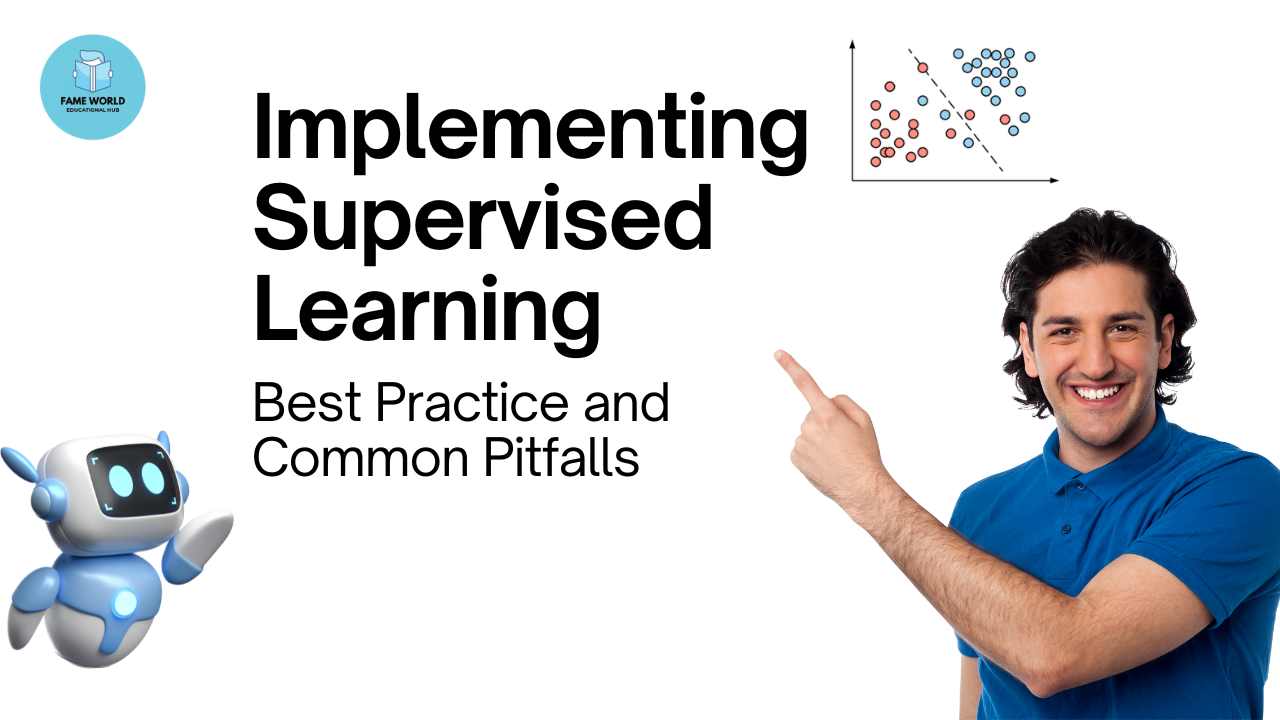Supervised learning is a fundamental machine learning technique where models are trained on labeled data. This method allows algorithms to make predictions or classifications based on input-output pairs. However, achieving effective supervised learning involves more than just feeding data into a model. It requires careful consideration of best practices and awareness of common pitfalls.
Understanding Supervised Learning
Supervised learning involves two main components:
- Input Data: Features or attributes that the model uses to make predictions.
- Output Data: Labels or values that the model aims to predict.
Types of Supervised Learning
- Classification: Predicting discrete labels. For example, classifying emails as spam or not spam.
- Regression: Predicting continuous values. For example, forecasting house prices based on features like location and size.
Best Practices for Implementing Supervised Learning
1. Data Preparation
a. Data Collection: Ensure you gather sufficient and relevant data. The quality and quantity of data significantly impact model performance.
b. Data Cleaning: Remove or correct inaccuracies, missing values, and inconsistencies. Clean data helps in building reliable models.
c. Feature Engineering: Create new features from raw data that might improve the model’s performance. This might involve domain knowledge to derive meaningful attributes.
d. Data Normalization: Scale features to a similar range, especially for algorithms sensitive to feature magnitudes like gradient descent-based methods.
e. Data Splitting: Divide your dataset into training, validation, and test sets. This helps in assessing the model’s performance and avoiding overfitting.
2. Choosing the Right Algorithm
a. Algorithm Selection: Choose an algorithm that suits your problem and data type. For classification, algorithms like logistic regression, decision trees, and support vector machines might be appropriate. For regression, consider linear regression or more complex methods like random forests.
b. Hyperparameter Tuning: Optimize algorithm parameters to improve performance. Techniques such as grid search or random search can be used for hyperparameter tuning.
c. Cross-Validation: Use cross-validation techniques to assess the model’s performance on unseen data and avoid overfitting. K-fold cross-validation is a popular method for this purpose.
3. Model Training and Evaluation
a. Training: Train the model on the training set while monitoring performance on the validation set to tune parameters and prevent overfitting.
b. Evaluation Metrics: Choose appropriate metrics based on your problem. For classification, metrics like accuracy, precision, recall, and F1-score are useful. For regression, metrics like mean squared error (MSE) and R-squared can be considered.
c. Model Interpretation: Understand and interpret the model’s predictions to ensure they make sense and align with business goals or domain knowledge.
4. Dealing with Overfitting and Underfitting
a. Overfitting: Occurs when a model performs well on training data but poorly on test data. Techniques to address overfitting include using simpler models, regularization methods (like L1 and L2 regularization), and early stopping.
b. Underfitting: Happens when a model is too simple to capture the underlying patterns in the data. To combat underfitting, consider more complex models or adding more features.
5. Ensuring Robustness and Generalization
a. Robustness: Test the model on different datasets to ensure it performs well under various conditions.
b. Generalization: Aim for models that generalize well to new, unseen data, rather than models that just memorize the training data.
Common Pitfalls in Supervised Learning
1. Poor Data Quality
a. Incomplete Data: Missing or incomplete data can lead to biased or incorrect models.
b. Imbalanced Data: Imbalanced class distributions can skew the model’s performance. Techniques like resampling or using class weights can help address this issue.
2. Feature Selection Issues
a. Irrelevant Features: Including irrelevant features can reduce model performance. Use feature selection techniques to identify and retain only the most relevant features.
b. Multicollinearity: High correlation between features can lead to multicollinearity issues. Techniques like variance inflation factor (VIF) can help identify and mitigate this problem.
3. Ignoring Model Evaluation
a. Lack of Validation: Relying solely on training accuracy can be misleading. Always validate models on a separate validation set to get a true sense of performance.
b. Over-reliance on Metrics: Relying only on performance metrics without understanding the model’s predictions can lead to incomplete assessments. Consider both quantitative metrics and qualitative analysis.
4. Overcomplicating the Model
a. Complexity: Using overly complex models can lead to overfitting and increased computational costs. Strive for simplicity where possible.
b. Lack of Interpretability: Complex models might be hard to interpret. Ensure that the model’s decisions are understandable and actionable, especially in critical applications.
Conclusion
Implementing supervised learning effectively requires attention to data quality, algorithm selection, and model evaluation. By following best practices and being aware of common pitfalls, you can build robust models that provide valuable insights and predictions. Continuous monitoring and iteration are key to maintaining model performance and relevance.
Remember, supervised learning is not a one-size-fits-all approach. Tailor your strategies to the specific needs of your problem and data, and you’ll be on your way to successful machine learning implementations.



